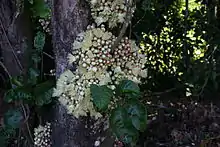Syzygium cormiflorum
Syzygium cormiflorum, commonly known as the bumpy satinash, is a species of Syzygium tree endemic to Queensland in northeastern Australia.
| Syzygium cormiflorum | |
|---|---|
 | |
| Scientific classification | |
| Kingdom: | Plantae |
| Clade: | Tracheophytes |
| Clade: | Angiosperms |
| Clade: | Eudicots |
| Clade: | Rosids |
| Order: | Myrtales |
| Family: | Myrtaceae |
| Genus: | Syzygium |
| Species: | S. cormiflorum |
| Binomial name | |
| Syzygium cormiflorum | |
| Synonyms | |
|
Eugenia hislopii F.M.Bailey | |
Taxonomy
Victorian colonial botanist Ferdinand von Mueller described the bumpy satinash as Eugenia cormiflora in 1865, from a collection by John Dallachy at Dalrymple's Gap near Rockingham Bay in Queensland.[1] It was transferred to the genus Syzygium in a revision of the genus in 1983.[2] Eugenia hislopii, named by Frederick Manson Bailey in 1913, is a synonym.[3] Common names include white apple, wild apple, watergum, Cairns satinash, and bumpy satinash.[4]
Description
Syzygium cormiflorum can grow as a tall rainforest tree to 30 m (100 ft) in height with a trunk 1 m (3 ft) diameter at breast height (dbh). Trees with flowers on branches grow larger than those with flowers on the trunk. The trunk in the latter form has a pronounced bumpy texture. Large specimens can have buttressed trunks. The bark is fibrous and flakey. The leaves range from 6 to 21 cm in length by 2.5 to 11.5 cm wide, averaging around 12.7 by 5.5 cm. The flowers appear on the trunk or larger branches over most months of the year except December and January, but peak over July to September. These are followed by white or cream fruit which are 3 to 6 cm in diameter.[5]
Distribution and habitat
The range is from Townsville to the Iron Range from sea level to altitudes of 1200 m, with cauliflorous forms more common at higher elevations and ramiflorous at lower elevations. It is found in rainforest.[5]
Ecology
The fruit is not particularly palatable to humans.[5] The southern cassowary eats the fruit and flowers.[4] The odoriferous black ant (Anonychomyrma gilberti) makes extensive tunnels in the cauliflorous form, particularly at the bumps where flowers grow.[5]
Cultivation
Syzygium cormiflorum is rarely grown in gardens. Generally propagated from seed, it can take 8 to 12 years to flower. It can be grown in subtropical climates.[6]
References
- "Eugenia cormiflora F.Muell". Australian Plant Name Index (APNI), IBIS database. Centre for Plant Biodiversity Research, Australian Government.
- "Syzygium cormiflorum (F.Muell.) B.Hyland". Australian Plant Name Index (APNI), IBIS database. Centre for Plant Biodiversity Research, Australian Government.
- "Eugenia hislopii F.M.Bailey". Australian Plant Name Index (APNI), IBIS database. Centre for Plant Biodiversity Research, Australian Government.
- Hyland, B. P. M.; Whiffin, T.; Zich, F. A.; et al. (Dec 2010). "Factsheet – Syzygium cormiflorum". Australian Tropical Rainforest Plants (6.1, online version RFK 6.1 ed.). Cairns, Australia: Commonwealth Scientific and Industrial Research Organisation (CSIRO), through its Division of Plant Industry; the Centre for Australian National Biodiversity Research; the Australian Tropical Herbarium, James Cook University. Retrieved 16 Mar 2013.
- Hyland, Bernie P.M. (1983). "A Revision of Syzygium and Allied Genera (Myrtaceae) in Australia". Australian Journal of Botany Supplementary Series. 13: 1–164. doi:10.1071/BT8309001 (inactive 2021-01-19).CS1 maint: DOI inactive as of January 2021 (link)
- Walters, Brian (November 2007). "Syzygium cormiflorum". Australian Native Plants Society (Australia). Retrieved 14 April 2012.
